Inside The New York Botanical Garden
Plant Talk
Posted in Uncategorized on May 19 2009, by Plant Talk
“Greening” Existing Buildings Works Toward Mayor’s Proposal
 |
Daniel Avery is Sustainability and Climate Change Program Manager at The New York Botanical Garden. |
On Earth Day last month, City Council Speaker Christine Quinn and Mayor Mike Bloomberg announced major new legislative proposals to increase energy efficiency in existing buildings. The measures, some of which will no doubt prove controversial (and, perhaps in some cases, difficult politically to get through), are a response to the reality of reducing emissions in a densely urban setting.
As perhaps you noticed the last time you strolled around your city block (or any city block), there are buildings everywhere, and collectively they contribute the vast majority—about 80 percent—of New York City’s greenhouse gases. In addition, of the buildings that will be standing in 2030, the date by which the Mayor’s PlaNYC 2030 envisions a 30 percent reduction in greenhouse gases from 2005 levels, 90 percent have already been built. This is why Rohit Aggarwala, Director of the Mayor’s Office of Long-Term Planning and Sustainability, said to The New York Times regarding the proposed legislation: “Existing buildings are in fact the nut that must be cracked if we are ever going to make a dent on the demand side in terms of energy.”
In terms of buildings, The New York Botanical Garden is much like the city: We have a lot of buildings of many different ages performing an astonishing number of different tasks. We represent, in short, a microcosm of the City’s challenge to reduce building-related emissions. And over the years we have been quietly going at this problem. Such efforts are not as visible or as easy to explain as new green buildings (if you find the list below exciting, you’re officially a policy nerd), but in many ways they are more challenging and more important.
Read More
Posted in Programs and Events on May 15 2009, by Plant Talk
Plant Edible Bulbs, Weave Onion-Dyed Cloth, and More
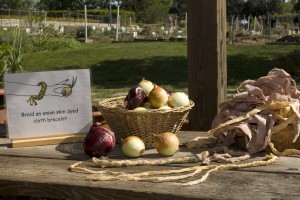 Here’s a sight not often seen at the Howell Family Garden: Toby Adams, Manager, holding back tears.
Here’s a sight not often seen at the Howell Family Garden: Toby Adams, Manager, holding back tears.
Truth be told, I didn’t see it either. One morning I wandered into the Family Garden by following the tasty smell of soup. Alas, it was not lunchtime. I learned instead, that in preparation for Bulbs Unearthed, part of the Dig, Plant, Grow! program at the Howell Family Garden, Toby and staff the previous afternoon had peeled several hundred onions in an act that must have made several grown men cry. Then they boiled the skins into a Macbethian brew of yellow and green dyes. Into this concoction went strips of cloth. After a brewing period, the fabric was set to dry in the sun. The end result of all that labor? Beautiful honey-colored material ready to be woven into bracelets by our visitors.
Our craft successes with onions so far have been most popular with folks with braiding experience. “More often than not, it’s the little girl teaching the father to braid,” staffer Junior Schoulton reports. Visitors not so adept at braiding, however, are welcomed to help our gardeners plant scallions or to use colored pencils to capture on paper the last tulip blooms fading from the meadow.
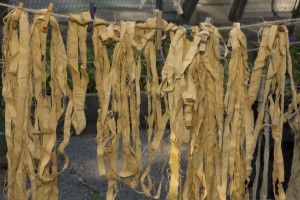 If all that isn’t enough, from 2 to 5 p.m. on June 6 and 7 staff from the Wyckoff Farmhouse Museum in Brooklyn will share traditional Dutch crafts with our visitors, such as they did this past weekend. The reception was enthusiastic: snacking on freshly churned butter with oregano, attempting to roll wooden hoops across the lawn, and decorating ceramic tiles were just a few of the activities the Wyckoff staff provided. Shirley, who happily operated the butter churn with the help of several visitors, confirmed the general enthusiasm. “The kids are loving it. Mostly it’s the parents who say, ‘That’s all there is to it? I’m going to make my own butter!’” Additional activities the Wyckoff staff will offer in June are apple pressing and ink-making as well as lessons in using quill pens.
If all that isn’t enough, from 2 to 5 p.m. on June 6 and 7 staff from the Wyckoff Farmhouse Museum in Brooklyn will share traditional Dutch crafts with our visitors, such as they did this past weekend. The reception was enthusiastic: snacking on freshly churned butter with oregano, attempting to roll wooden hoops across the lawn, and decorating ceramic tiles were just a few of the activities the Wyckoff staff provided. Shirley, who happily operated the butter churn with the help of several visitors, confirmed the general enthusiasm. “The kids are loving it. Mostly it’s the parents who say, ‘That’s all there is to it? I’m going to make my own butter!’” Additional activities the Wyckoff staff will offer in June are apple pressing and ink-making as well as lessons in using quill pens.
Although it’s a bummer to lose our tulip blossoms to the warming weather and heavy rain, I’ve noticed flowering onions’ purple tops puckering up by the pond. These gorgeous alliums allow the bulbs’ showy season to go out with a bang. My favorite bulb trick? Saving the giant alliums’ blooms to dry as Independence Day flower-fireworks!
Bulbs Unearthed will be featured in the Ruth Rea Howell Family Garden from 1:30 to 5:30 p.m. through June 7.
Check out all of Saturday’s programming
Check out all of Sunday’s programming
Posted in Gardens and Collections, People on May 14 2009, by Plant Talk
 Carol Capobianco is Editorial Content Manager at The New York Botanical Garden.
Carol Capobianco is Editorial Content Manager at The New York Botanical Garden.
On the surface, one would expect that the dozens of volunteers who answered the call to help plant 1,000 trees and 50 shrubs in the Botanical Garden’s Native Forest April 24 and 25 did so in observance of Arbor Day or Earth Week or Hands On New York weekend or just because it was an excuse to be outside on a warm, sunny spring day.
But dig deeper—in a figurative way, that is, as we were all instructed by our deft leader Forest Gardener Anthony Copioli to dig only as deep as each tree’s root system to keep the root flare above the soil—and you’ll find that those worthy causes for the most part didn’t factor in to the motivational equation. What inspired these folks, instead, was much earthier: They came because they love gardening, the outdoors, and the Botanical Garden, some from as far back as childhood. There is something about touching the soil that touches the soul. Simply, they needed to be out here.
Take Garden Member Marco Burmester, for instance. He grew up on a farm in northern Germany and has missed the woods and gardening since he moved to New York City four years ago. He took the day off from his banking job for the opportunity to plant a tree once again. “I used to do this in my childhood; I’ve planted hundreds of trees in my lifetime.”
Ellen Alger of Montvale, N.J., and Irene Ryan of Nanuet in Rockland County, rode their bikes to the Garden as kids growing up in the area. “We received so much from the Garden that it’s nice to give back and to put our mark on it,” said Ellen, who is a Garden Member.
The two became planting buddies for the day with Board Member Julie Sakellariadis, who lives in Manhattan and visits the Garden weekly to walk the grounds. “I look for any excuse to come up here, to be outdoors with no phones ringing. There’s nowhere in the world so wonderful as The New York Botanical Garden.”
The other volunteers would agree. “This is an oasis; it’s awesome that it exists in this urban area,” said Paula Lawrence, Vice President of The Starr Foundation, a Garden Leadership Donor. She joined five other co-workers—half the Foundation staff—to dig holes, cajole tangled pot-bound roots, and plant with a purpose some of the hundreds of trees, provided through the MillionTreesNYC program, that would help in the restoration of the Native Forest.
Read More
Posted in Uncategorized on May 13 2009, by Plant Talk
Bronx Officials Open Children’s Nutrition and Urban Farming Programs
 |
Nick Leshi is Associate Director of Public Relations and Electronic Media. |
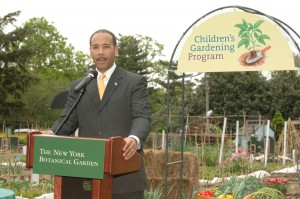
New Bronx Borough President Ruben Diaz Jr. spoke last week at The New York Botanical Garden’s Ruth Rea Howell Family Garden to officially open the vegetable gardening season. He recognized the Botanical Garden’s role in educating kids and the public about the importance of nutrition and healthy eating in combating obesity and other health issues and how community gardens help generate “green-collar” jobs in the city. Vegetable gardening and healthy eating will be showcased in The Edible Garden, a summer-long celebration of growing great food, June 27–September 13, at the Botanical Garden.
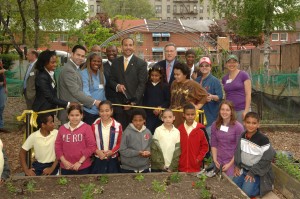
One of Bronx Green-Up’s community gardens, the Garden of Happiness on Prospect Avenue between East 181st and 182nd Streets in the Bronx, was abuzz with activity for the start of the gardening season. Among those on hand were, from left to right, Judge Dianne T. Renwick, City Councilman Joel Rivera, Community Gardener Karen Washington, City Councilman Larry B. Seabrook, Bronx Borough President Ruben Diaz Jr., New York Botanical Garden President Gregory Long, Bronx school children, and NYBG’s Director of Bronx Green-Up & Community Horticulture Ursula Chance (far right in purple shirt).
Photos by Jason Green
Posted in People, Science on May 13 2009, by Plant Talk
Garden Researchers Try to Understand, Address Challenge
  |
Karl Lauby, Vice President for Communications, interviewed Christine Padoch, Ph.D., Matthew Calbraith Perry Curator of Economic Botany, who works with her team in Amazonia to combat agricultural fires that now regularly devastate both forests and farms in the region.
|
What’s going on with fires in Amazonia?
Fire has been used in tropical agriculture for millennia. In the past, fires rarely escaped the fields where they were used to clear brush, control pests, and fertilize soils. Large fires escaping from burning fields and pastures have recently become common events, ravaging forests, farms, and settlements in much of Amazonia. Such destructive fires have become a major problem along the upper Ucayali River in the lowland Peruvian Amazon.
Why are today’s fires in the Amazon Basin different and so destructive?
Extensive clearing of humid forests for cultivation and pasture, especially along the eastern slope of the Andes, has increased the vulnerability of the region to escaped fires. A major drought in 2005 set in motion conflagrations that burned more than 300,000 hectares (about 741,000 acres) of forests in the neighboring Brazilian state of Acre, producing economic losses of more than $50 million in Acre alone. Although the 2005 drought was indeed an exceptional one, droughts of similar magnitude have occurred in the western Amazon in 1926, 1983, and 1998, with far lesser impacts on forests and people. An observer of the 2005 fires in Acre concluded they were “a disaster never previously experienced by modern societies in this part of Amazonia.”
What does your research involve?
The premise of the project is that fire results from an integration of social, ecological, and climatic changes that are occurring in the region. Controlling fire damage and anticipating future fire depend on understanding these changes and how they are linked. The project, funded by the Tinker Foundation, is exploring the increasing fire danger inherent in landscapes in transition, e.g., ones that combine small- and large-scale uses, traditional communities with plantations operated by urban-based companies. The work will produce insights that will have implications not only for much of Amazonia but also for developing regions around the tropics.
How is your research and the Botanical Garden’s work bringing about change?
Project results are helping policymakers, communities, and farmers avert even more fire catastrophes as global climate change affects the region. The project has developed activities specifically designed to inform policymakers, local scientists and technicians, students, and members of the area’s communities of the increased danger as well as of ways to use fire safely. Our methods include informal meetings, illustrated lectures, and training courses. We are working closely with the regional government in all our outreach programs.
Please help support the important botanical research, education, and programs that are integral to the mission of The New York Botanical Garden.
Posted in Learning Experiences, People on May 12 2009, by Plant Talk
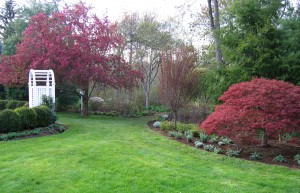
I was an eight-year-old boy growing up in Forest Hills, Queens, when my parents bought a country house. The house was overrun by thickets of wisteria, poison ivy, and weeds, but I used to go out there and just hack away and try to reshape the landscape. I believe that’s where my love for working on the land originated.
When I got to college I studied the natural sciences and art. After graduating I became a magazine art director, working for Time, Sports Illustrated, and Business Week for 25 years. Eventually, I reached that age when you need to figure out what you really want to do when you grow up. I started a personal exploration and one day everything came together. I decided that landscape design was the perfect match for all of my skills, experience, and interests. I could capitalize on my design and drawing skills, my natural science education, and my love for landscaping.
I looked around for different landscape design programs and settled on the program offered by NYBG. It would be difficult to go through the program one course at a time for me since I was living in Connecticut, working in Manhattan, and had a full-time family life. So I gravitated toward the Summer Intensive program. I managed to talk my employer into letting me take all of my vacation time at once.
To learn more about Jay’s career-changing experience…
Read More
Posted in Exhibitions, Programs and Events on May 8 2009, by Plant Talk
Family Concert, Plein Air Painting, Dutch History, and More
 Gayle Schmidt is Manager of Public Education.
Gayle Schmidt is Manager of Public Education.

We can all appreciate the beauty of the Garden especially now in spring, but there is so much that goes on behind the scenes to make it what it is, especially the exhibitions. For months, the horticulturists at the propagation range have been chilling and forcing bulbs to make them ready for The Glory of Dutch Bulbs, another beautiful show. This weekend we share some of those tips as we celebrate bulbs and Dutch culture with additional tours and home gardening demonstrations as well as with special guest lectures and programs.
The inspiration for the exhibition is the recognition of the 400th anniversary of Henry Hudson’s discovery of the region, and the weekend’s lectures bring to light the history of how the Bronx has been changed since Dutch settlement. Local historian Peter Derrick from the Bronx County Historical Society describes how the area developed from Dutch farms to the few parks and wild spaces that remain today. Pat Ernest, former educator at the Bartow-Pell Mansion Museum, speaks about the original residents of the Bronx, the Lenape, as well as Jonas Bronck, the first European to settle in the Bronx, in 1638.
Peter Rose, author and scholar, explores how Dutch recipes and customs changed in the New World. Through a lusciously illustrated slide presentation on the food and drink seen in the paintings of the 17th-century Dutch Masters, we discover the connections to the food we eat today. Samples of some Dutch treats will be available on a first-come, first-served basis after this lecture, which is sponsored by the New York Council for the Humanities, a state affiliate of the National Endowment for the Humanities. These programs take place in the Ross Lecture Hall, where visitors can also view The Heirloom Tomato exhibition on display in the Ross Gallery.
In the meadow of the Ruth Rea Family Garden, Wyckoff Farmhouse Museum staff re-create a playful day in the life of early Dutch settlers. If you take the trails of the Native Forest to get there, you can imagine what the whole of New York City looked like before any development took place.
On Mother’s Day the Bronx Arts Ensemble presents a musical performance for families, The House That Ruthie Built: A Bronx Baseball Fairy Tale. The audience is invited to participate in the entertainment as they learn about musical instruments and are amused by the actors having fun on stage.
Each Sunday during of The Glory of Dutch Bulbs, instructors from the Continuing Education department will lead Art in the Open Air: Plein Air Landscape Painting at various locations on the Garden grounds. We invite visitors to take a moment to study the surroundings and capture its beauty on paper by their own hand. The instructors will be there to coach you along and show some of their talent.
Don’t miss the additional activities this weekend—you are sure to take away some new understandings!
Check out all of Saturday’s programming
Check out all of Sunday’s programming
Posted in Shop/Book Reviews on May 7 2009, by Plant Talk
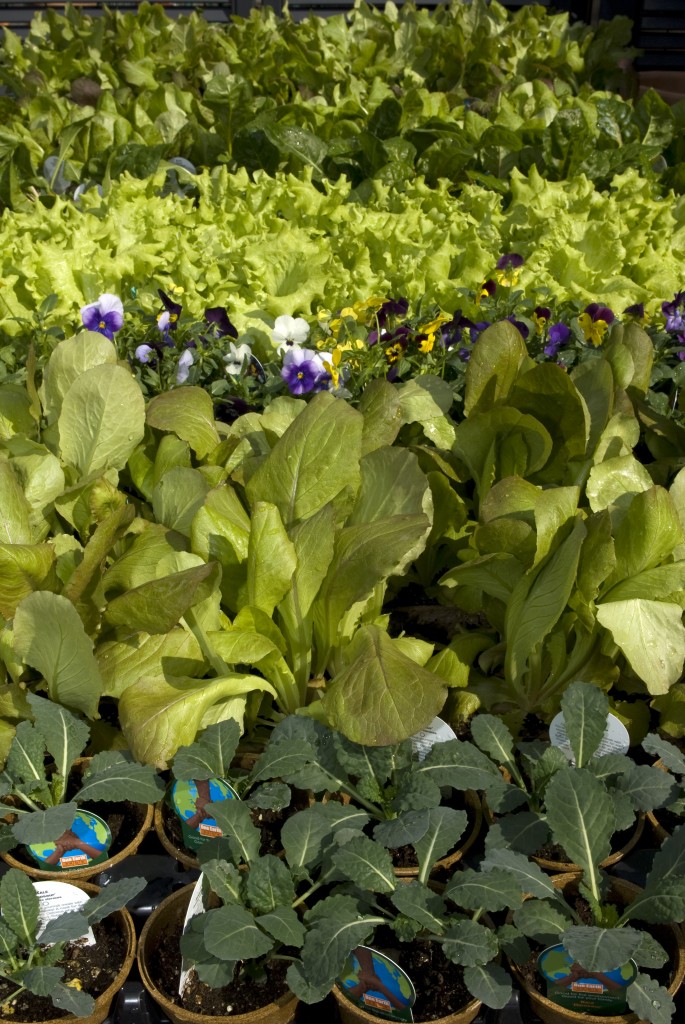
Throughout the planting and growing season you’ll find many varieties of USDA-certified organic edible greens, herbs, and vegetables available at Shop in the Garden, where you can also pick up tools, gloves, rain barrels, and more. Each purchase you make helps to support the many programs of The New York Botanical Garden.
Posted in Learning Experiences, People on May 6 2009, by Plant Talk
Graduating from the School of Professional Horticulture (SOPH) is much like any galvanizing event, as now my life is divided in two: “before SOPH” and “after SOPH.” Being a SOPH graduate has validated me as a horticulturist and empowered me to practice my skills with confidence. The two-year program is very intense as you do your best to absorb the endless information, learn from practical experience, and engage in the unique opportunities that are only available through the program.
Be forewarned: This is not an easy program; the commitment is enormous. But beyond what you learn in the course curriculum, it is entirely in your hands to seek out everything possible to make your experience that much richer.
Horticulture runs so deep and so wide that the taste I received from SOPH was only the beginning for me. I have grown in many ways from the foundation I built through the program. I am always looking for new ways to learn and to share my conclusions. My growth has revealed itself in my fascination of soil biology, and promoting its health is my professional philosophy. I am now certified by NOFA (Northeast Organic Farming Association) as an organic land-care professional, making the progressive commitment to practice horticulture in harmony with the environment.
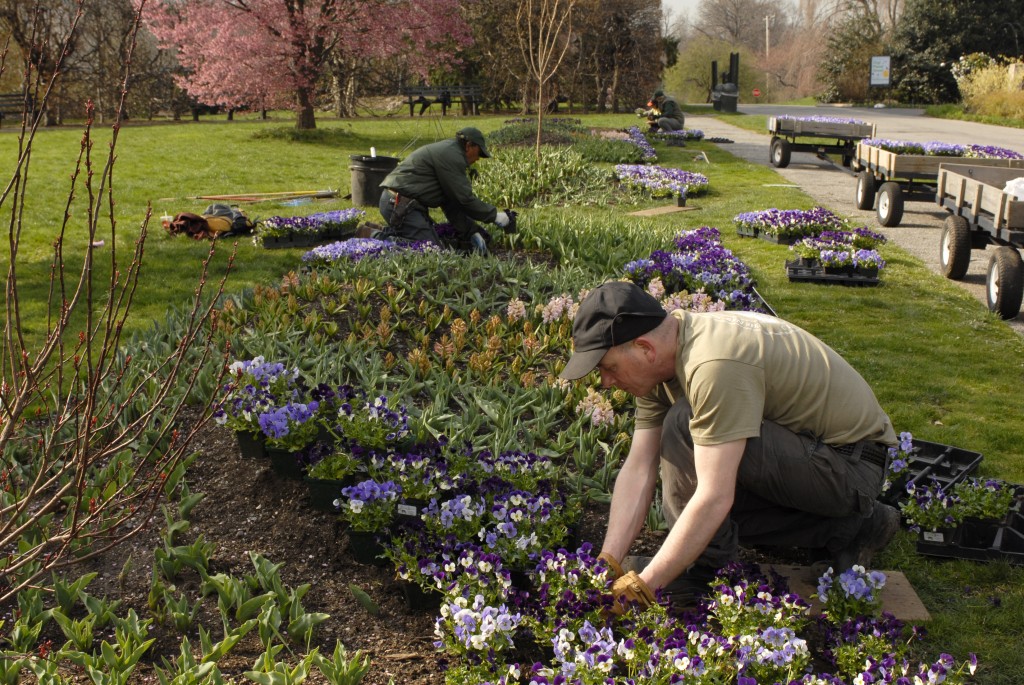
First-year SOPH student John Gunderson (foreground) plants violas in the Class of 2011 Spring Student Garden, located across from the Howell Family Garden.
Thanks to the public speaking classes at SOPH, I have the confidence to give lectures and presentations on garden topics. As a garden communicator, my blog, DirtyHorticulture.com, allows me to reach out to a broad group of gardeners. My consulting and design business, Living Colors Landscape and Gardens, is growing steadily thanks to the passionate clients I’ve acquired.
The climate is changing: not just the environment, but our awareness and actions, too. People are much more aware of their surroundings and are interested in preserving and protecting it. As horticulturists in the 21st century, it is our responsibility to offer comprehensive solutions for private and public spaces that are enjoyable to be in, do not stress our resources, and are prepared and maintained in responsible and accountable ways. We are the natural leaders of this “green revolution,” and so we must be prepared to empower others to follow.
The application deadline for the next SOPH class is August 15.
Posted in Learning Experiences, People on May 5 2009, by Plant Talk
 |
Louis Gagliano, a graduate of Continuing Education’s Floral Design program, is co-owner of Harlem Flo floral atelier, a floral boutique in Manhattan. He will talk about his path to becoming a floral designer at a free Career Information Session on Floral Design, Horticultural Therapy, and Landscape Design on Wednesday, May 13, 6–8 p.m., in the Arthur and Janet Ross Lecture Hall.
|
What is the path that brought you to where you are today? This is always the interesting question people ask when getting to know one another. It may at times be simple and at other times complex. Mine was the latter.
Growing up in a family business, I have always known the responsibility of ownership: Coming in early, leaving late, changing my plans…not the ideal situation but it comes with the territory. Knowing all this, I still chose to open my own floral design business with a partner.
The path to here, though, wasn’t direct. I graduated college with a degree in hotel/resort management and in 1994 went to work for a luxury Hilton hotel. After three years, I heard about this new-ish, booming coffee company called Starbucks and became a manager at one of its stores in New York City. My experience with Starbucks was fantastic and varied. Besides my role as a store manager, I opened new stores, became a training manager for soon-to-be managers and assistant managers, taught the basics of coffee and service, and was head of hiring retail employees for my district.
Seven years later, I left Starbucks and moved to Paris to fulfill a dream of living in one of the most beautiful cities in the world. All along I kept thinking that if I go back to New York City, maybe I should try a new career path.
With many years of managerial experience, well-established skills in customer-service training, a solid foundation in retail management, and an interest in flowers, I started to research areas that would match my strengths. I was returning to New York in June and found the Floral Design Summer Intensive program offered by The New York Botanical Garden.
To learn more about Louis’ experience at NYBG…
Read More


















